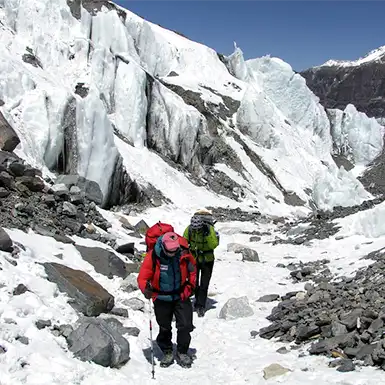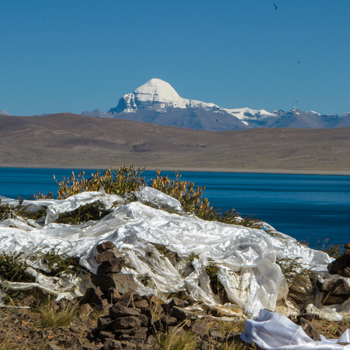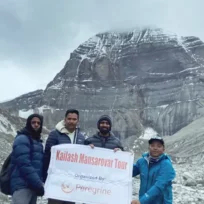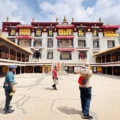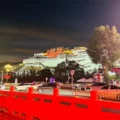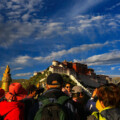Hiking in Tibet immerses you in an unparalleled experience. Explore the expansive terrain of the Tibetan Plateau, also known as the “Roof of the World,” which is burgeoning by colorful prayer flags, snow-capped peaks, and historic monasteries. Tibet treks blend physical challenges, cultural immersion, and breathtaking scenery uniquely.
The Tibetan Plateau boasts the Earth’s highest concentration of mountains above 7,000 meters, including Mount Everest. These dramatic landscapes are home to diverse ecosystems, ranging from arid valleys to crystal-clear lakes. Trekking in Tibet allows you to witness this geological wonder firsthand.
Culturally, Tibet is a land steeped in rich Buddhist traditions. Many treks weave past monasteries clinging to mountainsides, allowing you to glimpse the daily life of monks and pilgrims. The opportunity to experience this unique cultural tapestry adds another layer of depth to your Tibet Trek.
Top Trekking Routes in Tibet: Conquering the “Roof of the World”
Hiking in Tibet is an experience unlike any other. Imagine yourself traversing the vast landscapes of the Tibetan Plateau, surrounded by snow-capped peaks and imbued with rich spiritual significance. Tibet treks offer a chance to test your physical limits amidst breathtaking scenery and profound cultural encounters.
1. Mount Kailash Kora
One of the most captivating routes is the Mount Kailash Kora. This 52-kilometer trek, typically completed in 3 days, circumambulates the sacred Mount Kailash, revered by multiple religions, including Hinduism, Buddhism, and Bon. The trek is moderately complex, but the cultural and spiritual significance adds more depth. Legend has it that completing a clockwise circumambulation (kora) washes away sins.
Cultural and Spiritual Significance
Pilgrims from all walks of life undertake this pilgrimage through Tibet to honor Mount Kailash. Prayer flags flutter in the wind along the route, accompanied by mani stones inscribed with mantras and small shrines. Witnessing these traditions firsthand provides a glimpse into the deep faith that permeates Tibetan culture.
Best Time to Trek and Permits
The ideal time for a Mount Kailash Kora trek is between May and September when the weather is generally pleasant. Expect more crowds, though, as this is tourists’ busiest time of year. For fewer trekkers, consider October, although temperatures can drop significantly.
You must obtain permits for this trek through a reputable trekking company like Peregrine Treks. We manage to obtain permits and guarantee a smooth, culturally sensitive experience.
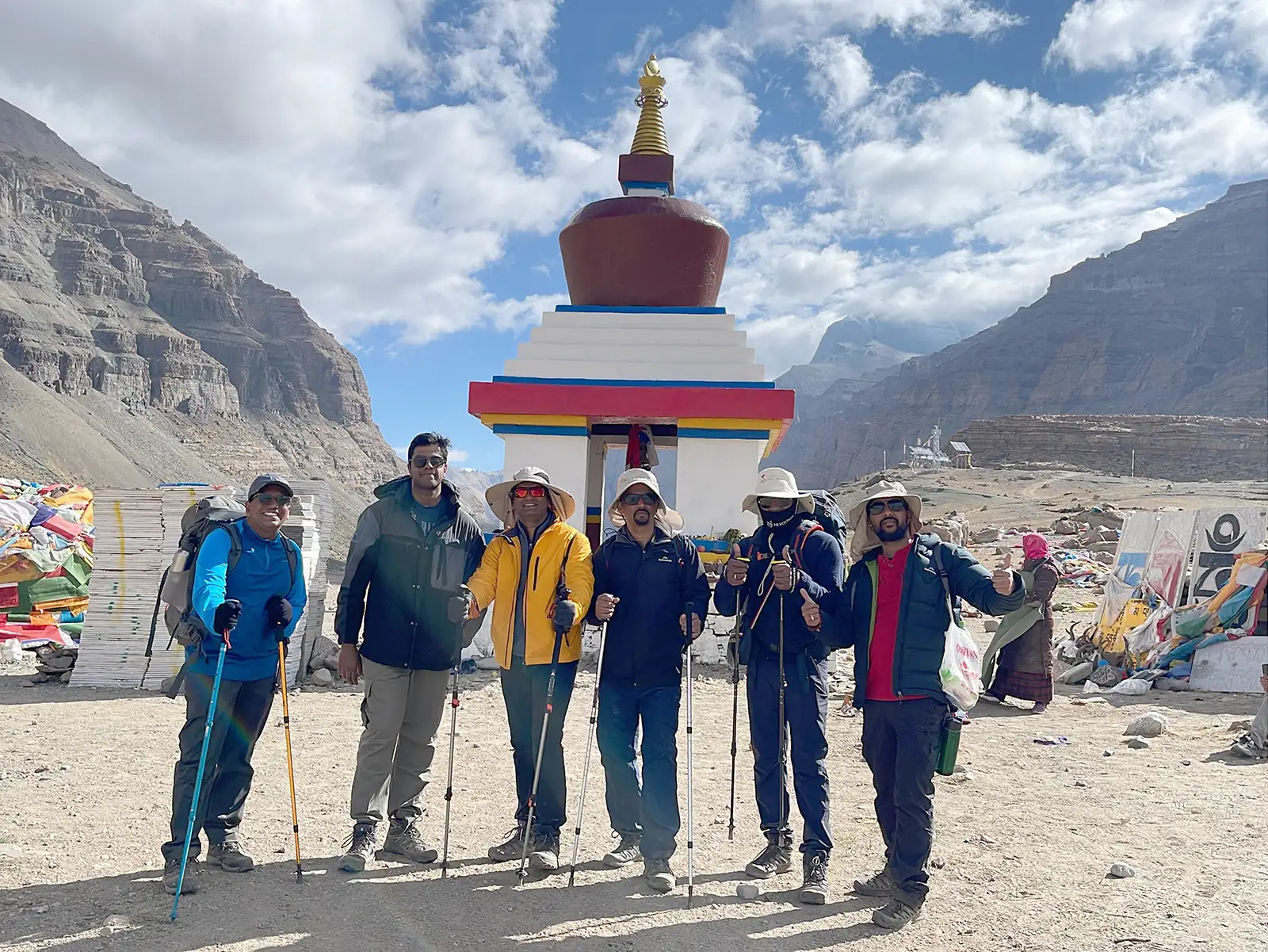
2. Everest Base Camp (North Face)
This Everest Base Camp Trek takes you on an unforgettable trip from Old Tingri, a small village nestled amidst towering peaks, to Everest Base Camp, situated at a staggering 5,200 meters. Due to its great altitude, the 84-kilometer trip is complex and requires adequate acclimatization.

The trek typically starts in Old Tingri, where you’ll have time to acclimatize to the altitude before beginning the gradual ascent toward Everest Base Camp. The route winds through valleys and over rocky terrain, offering breathtaking panoramas of the surrounding peaks, including the mighty Everest.
Highlights
One of the main attractions of this expedition through Tibet is undoubtedly the chance to see Everest up close. Nothing can ever get old about this fantastic vista of the highest mountain on Earth. Rongbuk Monastery, a tranquil monastery tucked away among the majesty of the Himalayas, is another noteworthy location.
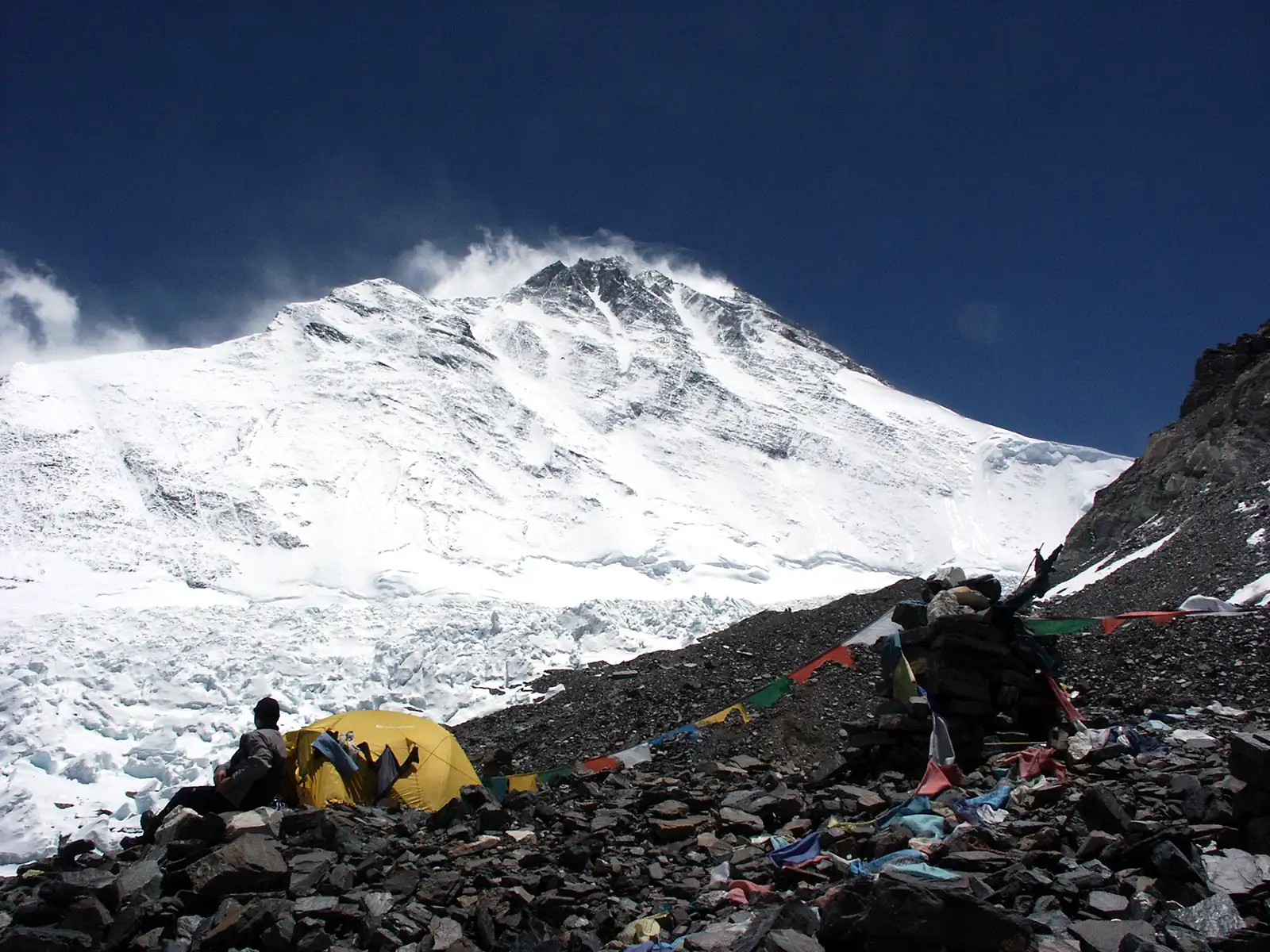
Acclimatization Tips and Duration
Acclimatization is critical for a successful Everest Base Camp (North Face) trek. Plan to spend several days acclimatizing to Old Tingri before starting the ascent. It lowers the chance of altitude sickness and enables your body to acclimate to the thin air. It usually takes 10–12 days to complete the hike, plus additional days for acclimatization.
Remember, proper physical conditioning is essential for tackling this challenging trek. Make sure you have the gear you need for high-altitude circumstances, and visit a doctor before you go, especially if you have any health issues.
3. Tsurphu to Yangpachen Trek
This Tsurphu to Yangpachen Trek offers a moderate challenge, stunning scenery, and cultural immersion. The 45-kilometer route, typically completed in 4 days, winds through picturesque valleys and rolling hills.
The trek starts at Tsurphu Monastery, the residence of the Karmapa Lama. Along the way, you’ll encounter serene monasteries offering a glimpse into Tibetan Buddhist traditions. The landscape transitions from lush valleys to arid plains, culminating in the dramatic Yangpachen Valley.

Difficulty and Season
This trek is excellent for people looking for a modest challenge with beautiful scenery because most fitness levels can complete it. Spring (April- May) and autumn (September- October) offer pleasant temperatures and clear skies, making them the best seasons for this trek.
Wildlife and Natural Attractions
Watch for wild yaks, Tibetan foxes, and various bird species that thrive in the high-altitude ecosystem. The Tsurphu to Yangpachen Trek also offers opportunities to witness the nomadic lifestyle of Tibetan herders, adding another layer to the cultural experience.

4. Ganden to Samye Trek
This Ganden to Samye Trek is a historical and religious adventure connecting two of Tibet’s most revered monasteries – Ganden and Samye. The 38-kilometer route, completed in 4-5 days, traverses diverse landscapes, testing your physical endurance and offering spiritual insights.
Historical and Religious Importance
Ganden, perched on a mountainside, was once the seat of the Gelugpa school of Tibetan Buddhism. Samye, Tibet’s oldest monastery, boasts a unique architectural style showcasing Indian and Chinese influences. Walking this route firsthand lets you experience the rich tapestry of Tibetan religious history.
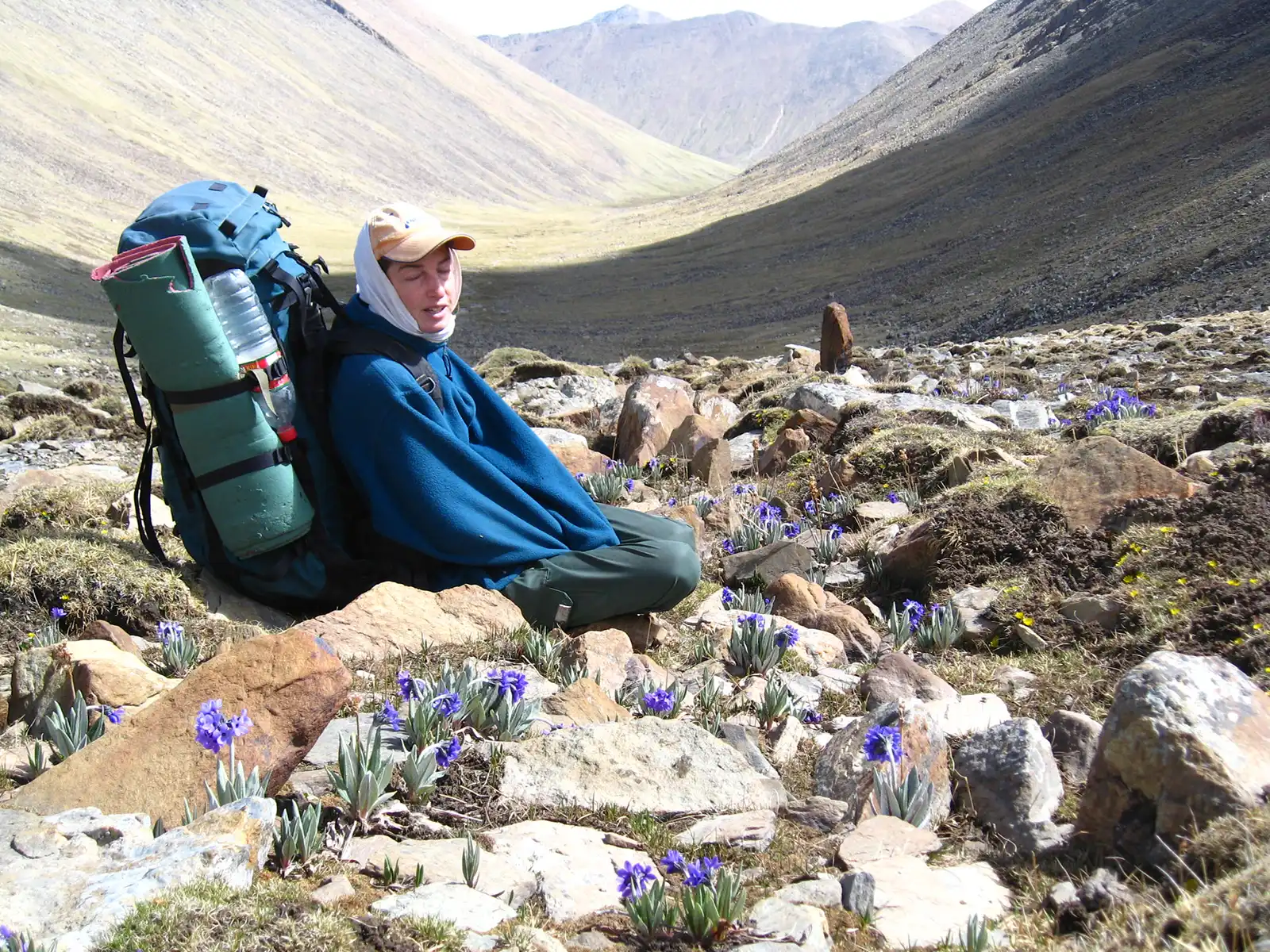
Varied Terrains and Altitudes
Because of the various landscapes, the trek is both demanding and rewarding. Await challenging ascents, especially to Ganden Monastery and valley descents afterward. The altitude changes can be significant, so proper acclimatization is crucial.
Tips on Navigating the Trek and Finding Local Guides
Consider employing a local guide familiar with the area and Tibetan culture, even though the path is marked. Local guides can navigate challenging sections, provide historical and religious insights about the monasteries, and ensure a smooth trekking experience in Tibet. Local guides can also help arrange permits and logistics.

Essential Preparation for Your Tibetan Trek
Hiking in Tibet promises breathtaking landscapes, profound cultural experiences, and a chance to push your physical limits. However, proper preparation is paramount for a safe and enjoyable Tibet trek. Here’s a comprehensive guide to ensure you’re well-equipped for your adventure:
Gear Up for the High Altitude
The key to a successful trek lies in having the right gear. The high altitude presents unique challenges, so staying warm and dry is crucial. Here’s an essential checklist to get you started:
- Backpack: Choose a comfortable and sturdy bag with enough capacity for your gear and supplies for the duration of the trek.
- Sleeping bag: Choose a high-quality, down-filled sleeping bag rated for sub-zero temperatures (around -15 °C).
- Tent: A lightweight, weatherproof tent is essential if your trek involves camping.
- Clothing: When preparing for the trek, pack layers of warm clothing, including thermals, fleece jackets, and a waterproof outer shell. Remember a hat, gloves, and warm socks.
- Footwear: Sturdy hiking boots with adequate ankle support are essential for handling rough terrain.
Health and Acclimatization: Your Top Priorities
Hiking in Tibet requires good physical fitness, especially for high-altitude treks. Consult your doctor beforehand, especially if you have any pre-existing medical conditions. Altitude sickness is a serious concern, so acclimatization is vital. Here are some tips:
- Gradual Ascent: Plan your itinerary to allow for gradual ascent. This adjustment period allows your body to adapt to the decreasing oxygen levels.
- Stay Hydrated: Even if you don’t feel thirsty, drink plenty of water throughout the day to stay hydrated. Dehydration can worsen altitude sickness.
- Listen to Your Body: When necessary, take days off from exerting yourself, and try not to push yourself too hard, especially when starting.

Essential Documents: Permits and Visas
Hiking in Tibet requires specific permits to ensure responsible tourism and environmental protection. A reputable trekking company like Peregrine Treks typically handles the application process to obtain the necessary licenses. Here’s what you’ll need:
- Tibet Travel Permit: All foreign visitors entering Tibet must have a Tibet Travel Permit.
- Tibet Trekking Permit: You need specific permits for different trekking routes. Your chosen trekking company can advise you on the necessary licenses.
- Chinese Visa: Before planning your trip, make sure to double-check the visa requirements for your nationality. Many nationalities require a visa application beforehand.
Unveiling the Tibetan Soul: Cultural Insights for Your Trek
Hiking in Tibet isn’t just about conquering mountains; it’s about experiencing a unique culture steeped in ancient traditions. Traveling through the stunning scenery, you’ll come across small towns and hallowed religious locations. Here are some cultural tidbits to enhance your trip across Tibet:
A Glimpse into Tibetan Rural Life
Trekking through rural communities is a standard route for Tibetans, providing an insight into their way of life. Here are some things you might encounter:
- Yak Caravans: Yaks are the backbone of the Tibetan economy, used for transportation, food, and clothing. Witnessing yak caravans traversing the mountains is a quintessential Tibetan experience.
- Nomadic Herders: You may encounter nomadic herders living a traditional lifestyle, herding sheep and goats across vast grasslands.
- Prayer Flags and Mani Stones: Along trekking paths, one may see countless bright prayer flags waving in the breeze and mani stones engraved with mantras. These represent the deep faith that permeates Tibetan culture.
Respecting Local Customs and Religious Sites
Tibet is a deeply religious society. Here’s how to be a respectful visitor:
- Dress Modestly: When visiting monasteries, in particular, wear conservative clothes. Keep your attire modest, and stay away from anything with offensive statements.
- Monastery Etiquette: Be careful of the noise levels in monasteries. It is not appropriate to point at religious statues or take off your shoes before entering.
- Photography Courtesy: Ask permission before photographing people, especially monks or nuns. Be respectful of prayer ceremonies and avoid using flash photography in religious sites.
Interaction with Local Communities
Hiking in Tibet often involves interaction with local communities. Here are some tips for a favorable exchange:
- Learn a Few Phrases: A basic greeting in Tibetan goes a long way. Learning “Tashi Delek” (meaning “good luck” or “hello”) shows respect for the local culture.
- Support Local Businesses: Purchase souvenirs from local vendors or stay in homestays run by Tibetan families. It boosts tourism revenue directly within the community.
- Be Mindful of the Environment: Trek responsibly without leaving any trace behind. Take out anything that you can to prevent upsetting the delicate mountain ecology.

Wildlife and Responsible Trekking in Tibet
Hiking in Tibet offers a chance to witness breathtaking scenery and a unique and fragile ecosystem. The Tibetan Plateau is home to various wildlife species, many adapted to the harsh high-altitude environment. Here’s what you can expect to see and how to be a responsible trekker:
A Glimpse of Tibetan Wildlife
As you traverse the diverse landscapes of Tibet, keep an eye out for these fascinating creatures:
- Endemic Species: The Tibetan Plateau boasts unique animals like the majestic Tibetan antelope, the elusive snow leopard, and the playful Tibetan fox. You might also spot the argali wild sheep with impressive horns or the Himalayan marmot basking in the sun.
- High-Altitude Birds: Predatory birds like vultures and lammergeyers thrive in Tibet’s clear skies. Look for the stunning iridescent plumage of the Himalayan monal pheasant.
Environmental Responsibility: Leave No Trace
Here’s how to minimize your impact and ensure sustainable trekking practices:
- Pack It In, Pack It Out: Bring reusable water bottles and containers to avoid generating waste. Carry all your trash back down to dispose of it properly.
- Respect Wildlife: Stay safe from wild creatures and don’t mess with their environment. Never feed wild animals because it may change their behavior.
- Minimize Campfire Impact: If campfires are permitted, use designated fire rings and only burn deadwood collected from the ground. Extinguish fires completely before leaving the campsite.
The Importance of Leaving No Trace
The concept of “Leave No Trace” is crucial for preserving the pristine beauty of the Tibetan landscape. By following these principles, you ensure:
- Protection of Ecosystems: Minimizing waste and respecting wildlife helps maintain the delicate balance of the Tibetan ecosystem.
- Enjoyment for Future Generations: Responsible trekking practices ensure that future visitors can experience the same pristine beauty you encounter.
- Positive Cultural Impact: Being a mindful visitor demonstrates respect for the Tibetan culture and its deep connection to the natural world.
Essential Tips for Hiking in Tibet
Hiking in Tibet promises an unforgettable adventure, but proper planning is essential for a smooth experience. This guide tackles the logistics, ensuring you have the information needed for a successful trek.
Finding the Perfect Season
The best time for a trek depends on your preferences and chosen route. Here’s a seasonal breakdown:
- Spring (April-May): Pleasant temperatures, but expect crowds, especially on popular routes. Be prepared for occasional rain or snow at higher altitudes.
- Summer (June-August): The warmest temperatures with minimal precipitation are ideal for high-altitude treks. However, strong winds and afternoon thunderstorms can occur.
- Autumn (September-October): Stunning fall foliage and clear skies make this season ideal for photography. However, temperatures drop significantly, so pack warm layers.
- Winter (November-March): This is the least crowded season, but it is extremely cold with heavy snowfall. Tibet treks are only suitable for some due to the harsh conditions.
Guided Tours vs. Independent Trekking
It can be done independently or on a guided tour. Here’s a breakdown to help you decide:
- Guided Tours are ideal for first-time trekkers, those seeking cultural immersion, and those on a tight schedule. Guides handle logistics and permits and ensure a safe and culturally sensitive experience.
- Independent Trekking offers more flexibility and a sense of adventure but requires experience, proper planning, and the ability to obtain permits independently.
Transportation, Accommodation, and Local Delights
- Getting to Tibet: Flying into Lhasa, the capital city, is the most common way to reach your starting point. Permits are required to enter Tibet, so book your trip through a reputable agency that can handle the application process.
- Accommodation: Accommodation options vary depending on the route. You might find guesthouses in villages, homestays with local families, or camping in designated areas.
- Tibetan Cuisine: Tibetan food is hearty and well-suited to the high altitude. Expect momos (steamed dumplings), yak meat dishes, and thukpa (noodle soup). Be prepared for more straightforward fare on remote treks.

Trekking Safely: Essential Considerations for Your Tibetan Adventure
Hiking in Tibet offers unparalleled beauty and cultural immersion, but safety should always be a top priority. Here’s a comprehensive guide to ensure a secure and enjoyable:
Staying Informed: Travel Advisories and Safety Tips
Before starting your Tibet trek, consult the latest travel advisories for Tibet. Here are some general safety tips to remember:
- Altitude Sickness: Tibet’s high altitude poses a severe health risk. It is essential to hydrate, acclimate properly, and ascend gradually. If you have any pre-existing medical conditions, speak with your doctor first.
- Weather Conditions: The weather in Tibet is only sometimes predictable. Depending on the season, be ready for abrupt temperature fluctuations, high winds, and perhaps rain or snow.
- Respect Local Customs: Dress modestly, especially when visiting monasteries. Be mindful of noise levels and photography etiquette in religious sites.
Understanding Regulations for Restricted Areas
Many traverse remote regions with restricted access. Here’s what you need to know:
- Permits: Permits are mandatory for all treks. A reputable trekking company typically obtains the necessary licenses and handles your application process.
- Restricted Areas: Certain areas in Tibet require special permits due to environmental or cultural sensitivity. Ensure your chosen trekking company has the authorization for your selected route.
- Travel Restrictions: Some areas may restrict foreigners from traveling independently. Opting for a guided tour ensures you comply with all regulations.
Emergency Contacts and Healthcare Access
While most Tibet treks occur in safe areas, prepare for any situation. Here’s what to know:
- Emergency Numbers: Store important emergency contact numbers, including those of your embassy/consulate and local emergency services, in your phone.
- Medical Facilities: There might be few medical facilities in remote areas. Think about taking necessary prescriptions and a simple first aid kit. See your physician for suggestions.
- Travel Insurance: Get all-inclusive travel insurance that includes coverage for medical emergencies, trip cancellations, and air evacuation in the event of a helicopter evacuation.
Personal Encounters on the Tibetan Trail
Hiking in Tibet isn’t just about reaching a summit; it’s a transformative experience that leaves a lasting impact. Here, trekkers share their personal stories and the profound effect of conquering the challenges of a Tibet trek:
Facing the Altitude on Everest Base Camp Trek
“The Everest Base Camp trek was physically demanding,” says Sarah, a seasoned hiker from Australia. “The altitude was a constant challenge, but the breathtaking views of Everest and the camaraderie with fellow trekkers kept me motivated. Reaching base camp felt like a personal victory, a testament to perseverance.”
Overcoming Unexpected Challenges on the Tsurphu to Yangpachen Trek:
“The Tsurphu to Yangpachen trek surprised me,” recalls David, a first-time trekker. “The weather changed rapidly, but our guide expertly navigated us through rain and wind. Witnessing the nomadic lifestyle firsthand was a highlight, a reminder of the simplicity and resilience of the Tibetan people.”
Finding Peace on the Ganden to Samye Trek:
“The Ganden to Samye trek was a spiritual trip,” shares yoga instructor Maria. “The serene monasteries provided a sense of inner peace. The challenging climbs symbolized overcoming obstacles, both physical and mental. I returned home feeling grounded and inspired.”
The Transformative Power of a Tibetan Trek
These are just a few examples of how hiking in Tibet can be a life-changing experience. Here’s what trekkers often report:
- Increased Self-Confidence: Conquering a challenging trek fosters a sense of accomplishment and boosts self-belief.
- A Deeper Appreciation for Nature: The majestic landscapes of Tibet inspire awe and a renewed appreciation for the natural world.
- Cross-Cultural Understanding: Interacting with local communities fosters a deeper understanding of Tibetan culture and traditions.
- A Renewed Perspective: The challenges and rewards of a Tibet trek offer valuable life lessons and a fresh perspective on daily life.
Reaching for the Roof of the World: The Enduring Rewards of a Tibetan Trek
Hiking in Tibet offers an unparalleled adventure that goes far beyond conquering mountains. It’s an opportunity to experience breathtaking scenery, encounter a unique culture, and test your physical and mental limits.
A Journey of Discovery Awaits
The rewards of a trek are plentiful:
- Witnessing Majestic Landscapes: Tibet has stunning natural beauty, with calm valleys, towering mountains, and endless glaciers.
- Experiencing Tibetan Culture: Encountering ancient monasteries, interacting with local communities, and witnessing traditional ways of life fosters a deeper understanding of this fascinating culture.
- A Personal Challenge: Range from moderate to challenging, pushing you outside your comfort zone and fostering a sense of accomplishment.
- Inner Reflection: The vast Tibetan landscape and the rhythmic pace of trekking can offer a deeply meditative experience, providing opportunities for self-discovery and achieving inner peace.
Trekking with Responsibility
Tibet treks take you through a delicate ecosystem and a land steeped in tradition. Here’s how to be a responsible visitor:
- Minimize Your Impact: Remember to pack out all of your waste, observe the “Leave No Trace” philosophy, and show consideration for the local fauna.
- Support Local Communities: Choose locally owned guesthouses, purchase souvenirs from Tibetan artisans, and contribute to the region’s economic well-being.
- Respect Cultural Sensitivity: When visiting monasteries, dress modestly, be mindful of noise levels in religious sites, and ask permission before photographing people.
Planning Your Dream Trek
With careful planning, your trek can be an unforgettable adventure. Here are some final tips:
- Choose the Right Route: Research different treks based on your fitness level, interests, and desired challenge.
- Invest in Proper Gear: High-altitude trekkers must bring specific gear and attire for comfort and safety.
- Consider a Guide: A knowledgeable guide can navigate the terrain, provide cultural insights, and ensure a safe and hassle-free experience.
- Prioritize Acclimatization: Gradual ascent is crucial for avoiding altitude sickness. Plan your itinerary with enough rest days to allow your body to adjust.

